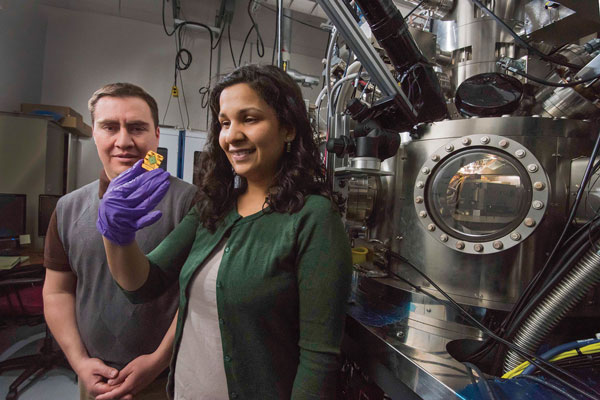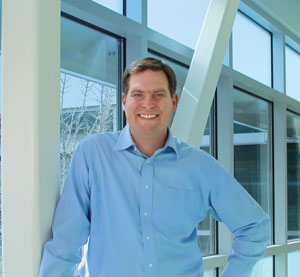With its qubits, entanglements and curious rules, quantum information can seem incomprehensible. But scientists are making sense of the riddles and shaping a remarkable quantum future.

A favorite story for those introducing the strange concepts of quantum science has to do with a cat postulated by a famous physicist, Erwin Schrödinger, to be neither alive nor dead, but maybe both, as it lay in a closed box. Only when the box was opened did the cat become either alive or dead. This paradox is so famous, though its meaning obscure, that even the non-technical New Yorker literary magazine ran a cartoon in 2015 of a man in a veterinarian clinic being told by a sympathetic nurse, “About your cat, Dr. Schrödinger — I have good news and bad news.”
Schrödinger’s fabled cat metaphor was his way of criticizing the prevailing school of thought in quantum mechanics and has both fascinated and befuddled people to this day.
Quantum physics — the fundamental theory of nature at small scales and low energies of atoms and subatomic particles — is difficult to understand because the behavior of particles at a subatomic scale contradicts everyday logic. That difficulty is partly why Sandia physicist Andrew Landahl became a quantum information scientist rather than a theoretical physicist: He says it’s easier to deal with what you can do with the rules of quantum mechanics than understanding how the rules work.
“Like a chess player,” he says, “I’m happy to accept the strange rules at face value and instead spend my time working out how to use the rules to play a great game.”
Quantum applied to national security
The application-focused “do” approach has produced impressive results.
“The SEQIS (Science and Engineering of Quantum Information Systems) Research Challenge at Sandia is now pushing unique capabilities out to all of our mission areas,” says Landahl. “We are now a go-to place across the entire federal government for quantum information science solutions to national security problems, cutting across stovepipes and impacting the whole laboratory.”
While some claim that a functioning quantum computer could crack many cryptography systems on Earth, including ATM codes and conventionally classified emails, the technique has more positive aspects. “We can build quantum seals to certify bonded transport or secure nuclear materials: Quantum seals are not locks, just extremely sensitive devices that can detect if even a single photon has been tampered with. And we can remotely monitor it; we don’t have to physically enter a radioactive area to read the sign,” says Landahl.
Quantum methods may eventually supersede the militarily vulnerable GPS satellite system that tells us where we are.
“Quantum information science is extremely practical,” amplifies Landahl. “At Sandia, we’ve used it to build an atom interferometer that traps atoms with laser beams so that the atoms act like a combination of an ultra-precise gyroscope, an accelerometer and a magnetometer all in one. This could outperform the GPS system by more than a factor of 1,000 and also work underground and underwater where satellite signals can’t reach.”
That is, GPS can’t help users when its signal is blocked by significant earth or water, but the atomic interferometer knows where it is and what time it is, in a basement or while scuba diving, just fine.
“The business end of our device currently fits in a shoebox, but the surrounding laser system still fills an entire optical table,” says Landahl. “Still, we have ideas for how to miniaturize that. GPS could be obsolete in 10 years because of quantum information science. “

A race to dominate
The U.S. currently enjoys a dominant position in information technology, he says, but that place is being challenged. “While our nation’s IT dominance is the envy of the world – we created the Internet, Google, Facebook – we could easily lose it. It may surprise you that the United States is not dominant in quantum information science. For example, China and Europe are each investing more than us, to the tune of billions of dollars.
Quantum information technology researchers produce more than 30,000 technical papers a year worldwide. This has stimulated investment from Sandia’s Laboratory Directed Research and Development (LDRD) program of $75 million since 2003. Sandia now can fabricate chips an atom at a time — one of two places on Earth able to do that — a helpful capability in building a quantum computer.
Maintaining the U.S. position in the 21st century will require advances in quantum information science: the intersection of quantum mechanics and information theory.
“Industry is now coming to Sandia for quantum information technology transfer,” Landahl has said in public talks. “They see a big future market in all of this. Market intelligence estimates peg the market at $5 billion by 2020. Both major companies and focused startups are getting on board. IBM alone announced in 2014 that it’s investing $3 billion over five years into the field. Quantum information science is going to be the business of the world, and it’s already becoming the business of our laboratory.”
On and off at the same time
The necessary ingredient throughout this work is the quantum bit — a qubit, which, like Schrödinger’s cat, is a switch that can be both on and off at the same time until it is measured. To form the switch, nature provides a wide variety of components: electrons judging which ions to infuse, atomic states, a particle of light or even the circulating current in a superconductor.
What makes qubits different from ordinary bits is the idea of quantum entanglement, a phenomenon in which the quantum aspects of several particles can’t be described separately from each other. This quality let Sandia researchers in a Grand Challenge LDRD project called SECANT link weak quantum processors together, offering the possibility of new computer architectures rather than attempt the formidable task of building a single large quantum computer. It may also enable distributed quantum sensing using correlations from multiple sensors.
“Entanglement is like the gasoline of quantum information science,” says Landahl. “It’s the source of all of the power.”
To which may be concluded: May the entangled quantum force be with us.
Meet Ryan Camacho
Ryan Camacho is a family man who spends a lot of time thinking about kids, his and others’, and where they are in life. He thinks back to the people who influenced him and how it guided his course.
Growing up in San Jose, California, Camacho’s path wasn’t clear. His father is an accountant and his siblings gravitated to business and the arts. But he enjoyed problem-solving. “I was the kid in class who liked math. I don’t know where it came from but going into science seemed like a good idea,” he says.
Camacho started college as a triple major — physics, electrical engineering and chemistry — and dropped two within a year. Physics was left standing. “It took me a while to know what direction I wanted to go, but then I knew,” he says.
His first lab partner in grad school had worked for Sandia and talked to Camacho about Albuquerque and the labs. Others talked about teaching, and after doing a postdoc at Caltech, Camacho considered taking a faculty job. Around the time he was applying, a Sandia recruiter came by and, reminded of his lab partner, Camacho signed on in 2010.

He works in quantum information science. “The flavor of my research has been doing quantum communications on a chip,” he says. “We are showing that you can do a lot of spooky quantum physics and put it on a useful, working microchip.” He works on Sandia’s Science and Engineering of Quantum Information Systems, or SEQIS, Research Challenge.
“It’s been amazing,” Camacho says. “Having a community at Sandia that’s interested in all aspects of quantum is terrific.”
Camacho shares what he has learned in life with youth in Albuquerque. He coaches math and chess and does science bowl programs in middle schools. “STEM [science, technology, engineering, and math] outreach is important to me,” he says. “I remember how it helped me as a kid. I want to be a part of other peoples’ lives.”
— Nancy Salem